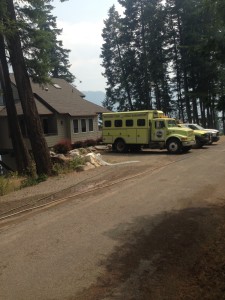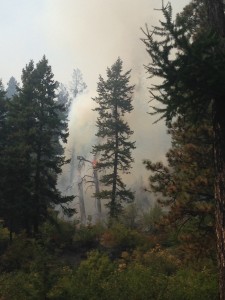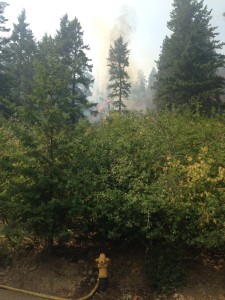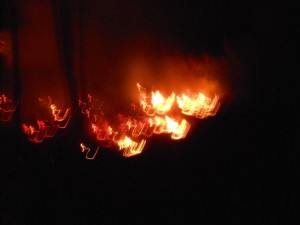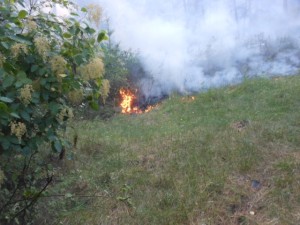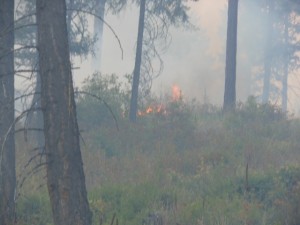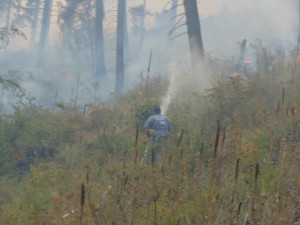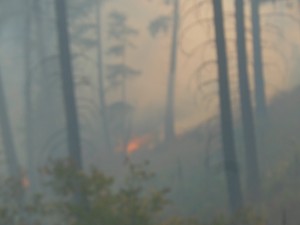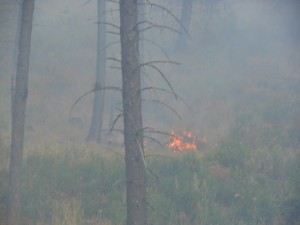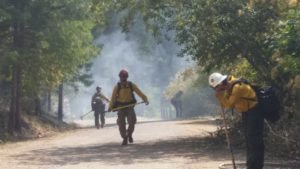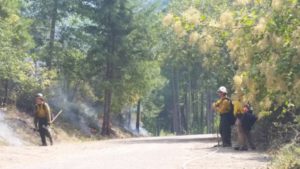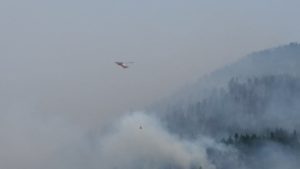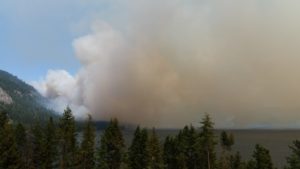Good Neighbors and Guardian Angels
by Rob B Vogel
(reprinted from Bayview Community Council Shore Lines, January 2016)
On July 5, 2015, a fire started out on Cape Horn near Bayview, Idaho. No one was sure of the fire’s origin, but it advanced steadily through the dry brush and pines on the cape headed in a northwesterly direction. The smell of smoke filled the air over the ridge and even though they could not yet see the flames, home owners and guests began piling valuable belongings, and insurance papers into cars and trucks, anticipating a quick getaway if need be. Lake Pend Oreille was crowded that weekend with Fourth of July vacationers and Bayview Daze partiers. The Pacific Northwest was in the middle of a prolonged heat spell and Idahoans and Washingtonians were only too glad to get out to a lake to cool down. But the long weekend ended abruptly with sheriff’s deputies, after assessing the spreading wildfire, advising evacuation now.
Folks from out of town headed home but the refugees from the cape mustered in downtown Bayview, many in Chan’s parking lot across from the Bayview Mercantile to monitor progress of the fire and the efforts to control, manage, and extinguish. No one knew what to expect but everyone could see the fire creeping toward town, first noticing billows of smoke rising over the summit then seeing flames devouring tall pines and hill sides. The residents, sick at heart, watched helplessly as forest department tankers dropped clouds of red-orange retardant and helicopters scooping big buckets of water out of the lake and pouring their thousand gallon loads on trees and slopes. Still, the fire kept slowly making its way north and west and toward town.
What they didn’t know about were 13 homeowners who didn’t evacuate despite the recommendations of deputies and emergency responders. These brave community members stayed to fight the fire advancing on their houses as well as their neighbors’ houses. Using a small trailer filled with firehoses and equipment stashed for such a circumstance, they managed to keep the fire at bay for nearly 48 hours until fire crews arrived to help on Tuesday. By that time, the head/front of the fire had moved a few miles north and west but left much of the cape smoldering, smoking, and overrun with burning embers that were still a grave threat to many of the houses and vacation homes built on hills and cliffs overlooking Idaho’s largest lake.
This volunteer neighborhood fire fighting brigade had no training for fire fighting nor any plans when the fire began burning. But the fortunate presence of Cape Horn residents Rich Powell, a retired fire chief from Flint, Michigan and Rich Doney, a retired police detective from Monrovia, California gave them the direction needed in harnessing their efforts and coordinating the necessary tasks. According to Doney, “Rich Powell was 110% in his element.” Powell began directing efforts with Doney using his police emergency preparedness training to help coordinate actions.
The fire fighters were fortunate to have help from a small trailer constructed some 16 years ago by Powell and Larry Janusch, another Cape Horn resident. These two men had the foresight to realize that emergency help from Kootenai County would be, at the minimum, over 10 miles and at least 30 minutes away. Adding to the difficulty of such an issue was the fact that Cape Horn Road is the only access in or out of the cape. (It turned out that the official fire crews who continued the battle and finally extinguished the blaze were not even on the scene until Tuesday, over 48 hours later.) Powell and Janusch acquired donated fire equipment, including about 3,000 feet of fire hoses and nozzles to stock the trailer for just such a circumstance. Using these fire hoses along with garden hoses, the 13 ad hoc fire fighters (dubbed the “Dirty Baker’s Dozen” by another local resident, Jim Wilkuski) worked around the clock digging fire breaks, watering down hot spots, and keeping the fire from destroying the hundreds of homes, garages, sheds and assorted structures on Cape Horn.
“We worked around the clock,” said Doney “and grabbed sleep breaks and food breaks when we could.” During these respites, they would talk about what they were doing and what they were going to do to maintain a hold on the wild fire progress. Neighbors who weren’t there and other Bayview citizens were calling and asking what they could do to help. Some of them snuck in on boats to bring food and water and other supplies. According to Doney “there was a strong sense of esprit de corps.”
When official fire crews finally arrived to take over, they complimented the Cape Horn 13 for their work. Because of their brave efforts, only six houses were lost to a fire that eventually burned nearly 1,400 acres, engaged fire fighting crews from nine western states, and took over a week to contain. The residents continued to help by providing support for the professionals.
What motivated them to take such dangerous actions was that basic “good neighbor philosophy.” The family is the basic unit of a society, and it follows that the community is an extension of the family. A community is made up of residents and neighbors who, hopefully, feel a connection to the group, a sense created through concern and compassion, and built with respect, consideration and trust. If you want that feeling of having good neighbors, you have to be a good neighbor.
Three weeks after the fire, the Cape Horn Estates Homeowners Association held a testimonial barbecue to thank the 13 individuals for their efforts in fighting the fire and saving dozens of homes. Feelings of pride and gratitude were palpable at this memorial for those who fought the fire for nearly two days straight, keeping hillsides and roofs wet, and dousing embers to keep them from reignited the tinder dry ridge.
The Cape Horn 13: Rich Doney, Vince Smith, Richard & Lee-Ann Powell, Tim & Linda Sigler, Doug Peterson, Tom Bumgarner, Dan Hanenburg, Richard Heinzen, George Ream, Andy Cleveland (Dan Hanenburg’s son-in-law and a non-resident), John Olsson (another visiting non resident).
Proudly wearing blue shirts identifying their ad hoc fire fighting team, they were able to explain how they performed their community service. Doney, who is also the Cape Horn Estates Homeowners Association President presided over the meeting, telling the story of the ones who stayed to fight as well as the official update on the status of the fire. He also talked about what they could learn from the fire and some steps to consider to improve their fire readiness in the future. The association now has a fire fund with over $8,000 to purchase more equipment and continue preparedness for future emergencies.
Hosts Eric and Rita Forsythe provided a feast for the celebration, with steaks, rotisserie chicken, salads, desserts, and drinks. Initially expecting a celebration on the lawn overlooking the beautiful alpine lake, festivities were moved into the garage because of an unexpected and rare July thunderstorm that dropped an inch of rain on the cape and the lake in a few hours’ time.
Many people took the chance to speak up and express their thanks but when Jim Wilkuski took the floor, he borrowed from Winston Churchill’s famous speech: “Never have so many owed so much to so few.” Though they showed a slight swagger while telling the story, laughing at some of the experiences and shaking their heads at others, the 13 were still humbled enough to nod to the many thanks and expressions of gratitude they received from those neighbors they knew, and those they did not. Feelings of not just gratitude and pride, but belonging and selflessness, relief and control, kindness and affinity. It was a powerful sense of community on that afternoon, this sense of involvement and connection with others. We see the evidence of community on occasion whenever catastrophes occur. People coming to help their families and friends, neighbors, and sometimes even strangers, when homes and lives are torn apart. It seems to be part of the human condition but Americans can be particularly good at this behavior: concern for those in your community, from local to global.
Because it’s the relationships that matter: our families, our friends, our neighbors. The connections with other people. They’re part of our social and cultural identity. They are the way we measure the quality of our lives, not by what we have, but what we have given, and what we have shared with others. They give us hope for the future.
As a new year begins, we can expect many changes, from new ideas and technologies to new political directions that occur in an election year. But many things we will hope to keep: Our health and prosperity, our hopes and dreams for a brighter future, and for those who are lucky enough to have it, that sense of community that is still part of the American dream.

